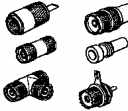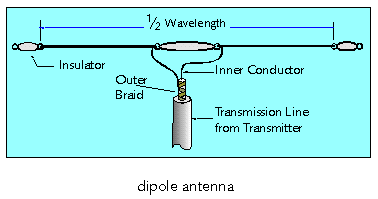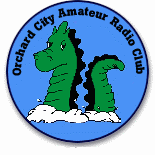

|
|
The "wet" numbers represent worst case for lines covered with ice or snow. |
Here's a quick line loss calculator to use Note that the simple program used for this web page gives a very close approximation for additional losses due to SWR.
|
|
|
Online Coax Cable Loss / Antenna Gain Calculator
This program is provided "as-is". It is thought to be accurate but it is the responsibility of the user to verify the accuracy of the calculations when using this program.
INTRODUCTION-The longwire antenna is a very effective antenna for the
listener who wants to cover all of the shortwave bands from 530 KHZ to 30 MHZ.
However if you have some favourite frequencies that you listen to on a regular
basis you may wish to consider a dipole antenna. This antenna is a fairly easy
to construct antenna and will give you better reception on the frequency it is
cut for. Think of a dipole as a longwire that has a insulator in the
middle.
FREQUENCY-A dipole antenna will not only work well on the
frequency it is cut for, but also for the multiples of that frequency. For
example if you cut a dipole for 7.0 Mhz will also work well on 14 Mhz, 21 Mhz
and 28 Mhz. This way if you can pick and choose your frequency you can make one
antenna work on two or three bands.
LENGTH- To find out how long the
antenna should be all you have to do is fill in a simple formula:
468
divided by FREQUENCY IN MHZ = LENGTH IN FEET
300 divided by FREQUENCY
IN MHZ = LENGTH IN METERS
That is the only formula you need ever
know to build a dipole antenna.


CONSTRUCTION- Once you have selected a frequency and calculated the length of
wire you need add two feet to this length. This is done so you will have six (6)
inches of wire at each end to wrap around the insulators. Once you have this
extended length of wire cut it in half. This will give you both sides of the
dipole.
Attach an end insulator to one end of each piece of wire. You can
use the egg shaped insulators sold by many radio supply stores or make your own
out of a piece of plastic. This can be done by cutting a piece of heavy plastic
or plexi-glass to a size of about six (6) inches in length and about 2-3 inches
wide. Drill a small hole one to one and a half inches from each end of the
plastic to wrap the wire around. It is best to solder these connections and wrap
them in a sealant tape to keep the effects of the weather from harming
them.
The other free ends are attached to a center connector which you
can buy with a built in coaxial cable connecter, or make your own. This will
look similar to the end connectors but you will have to find a way to secure the
coax lead wire to the insulator. If you build your own when you attach the coax
to the ends of the wires, insure that you solder and wrap the connections. One
wire will go to the center of the coax, while the other wire will go to the
shielded braid of the coax. This will give you a perfect half wave dipole. You
should also wrap the coax fitting of the commercially available center insulator
to keep water and other moisture out. Moisture will ruin the connections on any
type of insulator and make the antenna less effective or at worst
useless.
MULTI-BAND DIPOLES- As was stated above you can use the dipole
on the harmonics or multiples of the frequency it is cut for. However if you are
short on space you can build a multi-band dipole. This way you will get an
antenna that will operate on several frequencies. Instead of using a single
strand of wire you can use wire that has several insulated wires in it. These
MUST be insulated wires to insure that they do not touch each other. You then
cut the top wire to be the longest, the second wire to be the second longest,
the third wire to be the third longest etc.. Only the longest wire is attached
to the end insulators and all wires are fed to the center insulator to attach to
the coax feed line.
INSTALLATION- Once you have the antenna cut all you
have to do in put it between two masts. Make sure that you use the free side of
the end insulators to attach some rope. Tie this rope from the end insulators to
the masts. Leave some slack on the antenna. If you pull too tight the antenna
will break in the wind or if snow and or ice should coat the antenna. KEEP AWAY
FROM OVERHEAD WIRES!! Keep away from these as should the antenna ever come into
contact with an overhead wire you will do permanent damage to your radio if not
yourself. All you have to do is feed the coax to your radio and listen to the
stations come in. It would be best to install a lightening arrester in the coax
feed line to help protect your receiver. These are available from many radio
supply stores. Follow the instructions carefully! In areas where thunder storms
or snow storms are common a lightening arrester is a must for safety.
You can install them flat or at an angle. If at an angle they will be more directional the direction that they are sloped. You can also install them as an inverted V shape. This dipole has a higher center with lower ends to save on space in smaller back yards. All three versions work well.

|

|

|


|

|

|